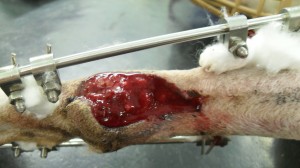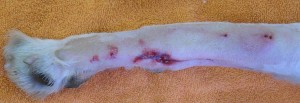External fixation is a way of fixing fractures that sometimes troubles owners but rarely troubles their pets! Pins come out through the skin and are joined to a connecting bar by a series of clamps.
Owners are often a little worried by the sight of metal pins sticking out of their pet’s leg, but the pet is just grateful that the bits of bone are now held firmly so that they aren’t grinding around on each other and hurting! Most animals will walk around quite happily on an external fixator, usually from the day of surgery. It is not uncommon for a dog with an external fixator to go outside for his first pee after placing a fixator and standing on it to cock his other leg!
The biggest problem for an owner, when pins are sticking out, is that the pins and bar can hook up on things like curtains, carpets, radiators, electric cables etc. So close confinement or supervision is usually required while the external fixator (the “frame”) is in place.
External fixators have some huge advantages. They can often be placed “closed” without surgically opening the patient’s limb. Simply by feeling for anatomical landmarks, pins can be inserted through tiny holes in the anaesthetised patient. External fixators can often be removed consciously, or just under light sedation, without the need for another anaesthetic. External fixators have fewer complications when they are placed into bone through a minimum of overlying soft tissue, and this means they are well suited to injuries of the lower limb.
External fixation is often the best, if not the only, way of fixing “open” fractures where the trauma has exposed the bone through holes in the overlying soft tissue and skin. These wounds are inevitably contaminated with bacteria. If metal work like plates and screws were used internally, then the bacterial contamination of the injury would be very likely to develop into a full-blown infection of bone which could be a serious and limb-threatening and possibly life-threatening problem.
Young, growing patients frequently get fractures of the midsection of the tibia. External fixation is usually ideal for these injuries. These fractures heal fast, especially if they are treated “closed” – ie. not opened surgically and interfered with. The problem is not getting these fractures to heal, it is getting them to heal straight. The pins and connecting bar of an external fixator allow the fragments of bone above and below the fracture to be accurately aligned. Once this is checked by x-ray, the clamps can be tightened to rigidly fix the fracture in alignment.
While dressings and casts might be considered for some injuries, external fixators have big advantages (clinical and often financial) over dressings:
Fixators don’t need changing every few days like dressings, which usually require sedation if not an anaesthetic. This can prove expensive.
Fixators don’t immobilise the joint above and below the injury like a cast or a splint. Joints don’t like being immobilised – if joints are restricted in motion for any period of time, then stiffness, loss of range of motion and reduced thickness of articular cartilage can result.
Rigid dressings can be heavy for small patients to move around in. Fixators are usually much easier for them to manage.
Dressings can slip down the leg, or get wet when the pet is taken out for toileting. A slipped dressing gives no immobilisation to the fracture, and the extra weight and leverage on the injury makes things worse. A wet dressing can lead to huge problems like skin sores.
Underlying skin sores are relatively common when dressings are kept on for several weeks.
An external fixator allows traumatic soft tissue wounds around the fracture to be treated comfortably in the conscious patient; if the fracture doesn’t move because the fixator is holding it rigidly in place, the patient doesn’t object and so sedation and anaesthetic isn’t required.
11th May 2013




